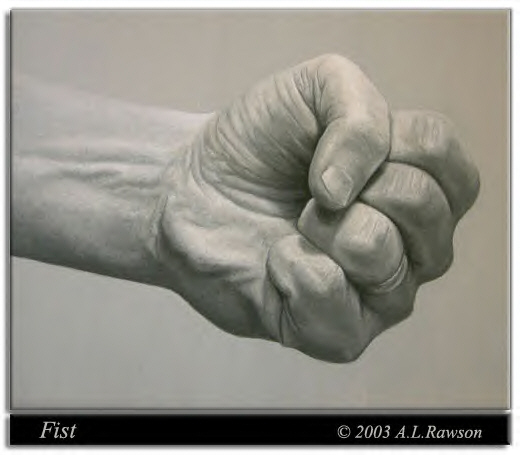FIST

Usage: Clenched fists signal an aroused emotional state, as in aggression,
anger, excitement (e.g., to cheer on a team), or
fear. In a business meeting, unconscious fisting is a
visible sign of anxiety (see SELF-TOUCH) or unvoiced disagreement (see PROBING
POINT).
Culture. In Pakistan, displaying a clenched fist
toward another is a nonverbal sign used to display an "obscene insult" (Morris
1994:71).
Thumb-over-fist. One may soften the impact of an aggressively fisted gesture by placing the thumb's fleshy, rounded tactile pad atop the fist's flexed index finger. In the Lincoln Memorial in Washington, D.C., the 1922 sculpture of a seated Abraham Lincoln by sculptor Daniel French featured the president's fleshy thumbs to humanize the monumental, 19-foot-high, 120 ton statue. In the same way, the thumb-over-fist gesture, first used by President John F. Kennedy in the 1960s, became an effectively assertive cue used to emphasize speaking points without seeming to be overly aggressive in the process. After Kennedy, numerous U.S. politicians, including Presidents Bill Clinton and Barack Obama, used the thumb-over-fist cue to show strength, to humanize their political speeches, and to disarm and connect emotionally with voters. Though an influence has not been demonstrated, I can't help but think the sculpture of Mr. Lincoln's rounded thumbs somehow shaped Mr. Kennedy's thumb-over-fist gesture.
World politics. In 1968 the raised fist (see HIGH-STAND DISPLAY) was broadcast to a worldwide TV audience, as it was presented by U.S. Olympic medalists as a power salute demonstrating defiance from the victory stand (Blum 1988). Politicians who have used the aggressive fist gesture to hammer home rhetorical points include Adolph Hitler, Nikita Kruschev, and Manuel Noriega (Blum 1988).
RESEARCH REPORTS: 1. "Rage, anger, and indignation are exhibited in nearly the same manner throughout the world. . . . There is, however, an exception with respect to clenching the fists, which seems confined chiefly to the men who fight with their fists" (Darwin 1872:242). 2. In nursery school children, the beating movement ". . . is an overarm blow with the palm side of the lightly clenched fist. The arm is sharply bent at the elbow and raised to a vertical position then brought down with great force on the opponent, hitting any part of him that gets in the way" (Blurton Jones 1967:355). 3. Blind-and-deaf-born children clench their fists in anger (Eibl-Eibesfeldt 1971:12). 4. In the infant's transition to sleep, "Fists closed for more than several seconds indicate increasing fatigue or distress . . ." (Papousek and Papousek 1977:70). 5. The closed fist is a widespread gesture of power and triumph, and a worldwide sign to show forceful emphasis and threat (Morris 1994:70, 72-73).
Antonym: PALM-UP. See also GOOSE -STEP.
Copyright 1998 - 2016 (David B.
Givens/Center for Nonverbal Studies)
Studio shot of a tightened fist (copyright 2003 by A. L. Rawson)